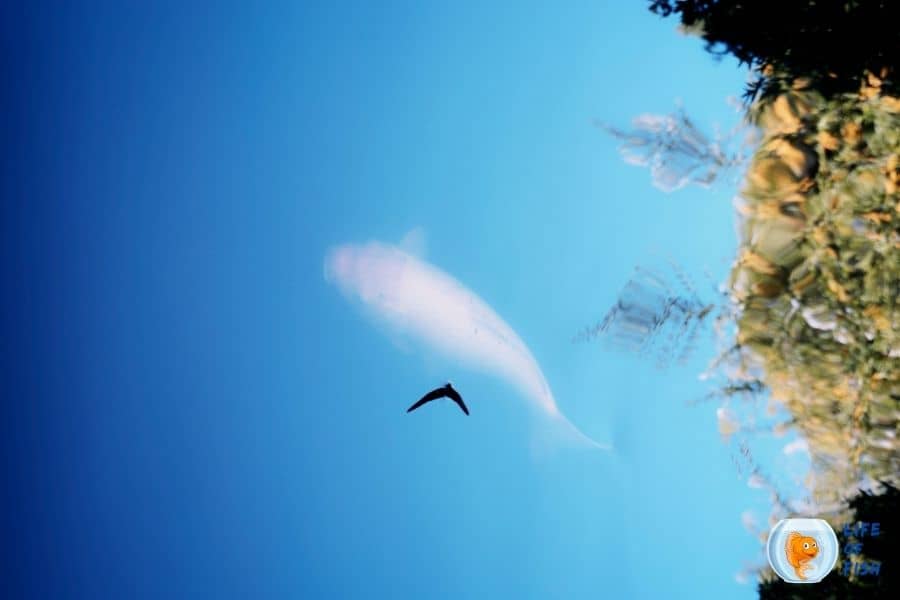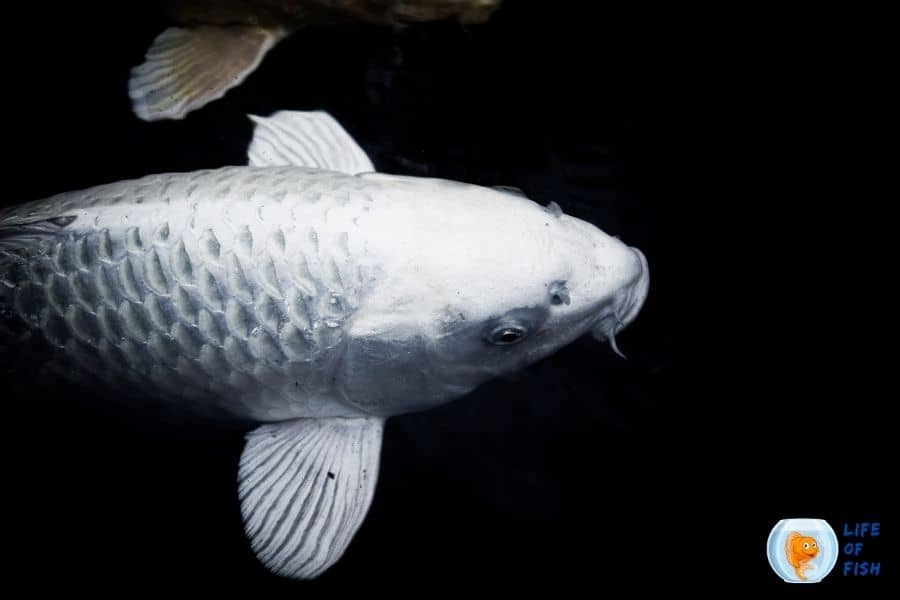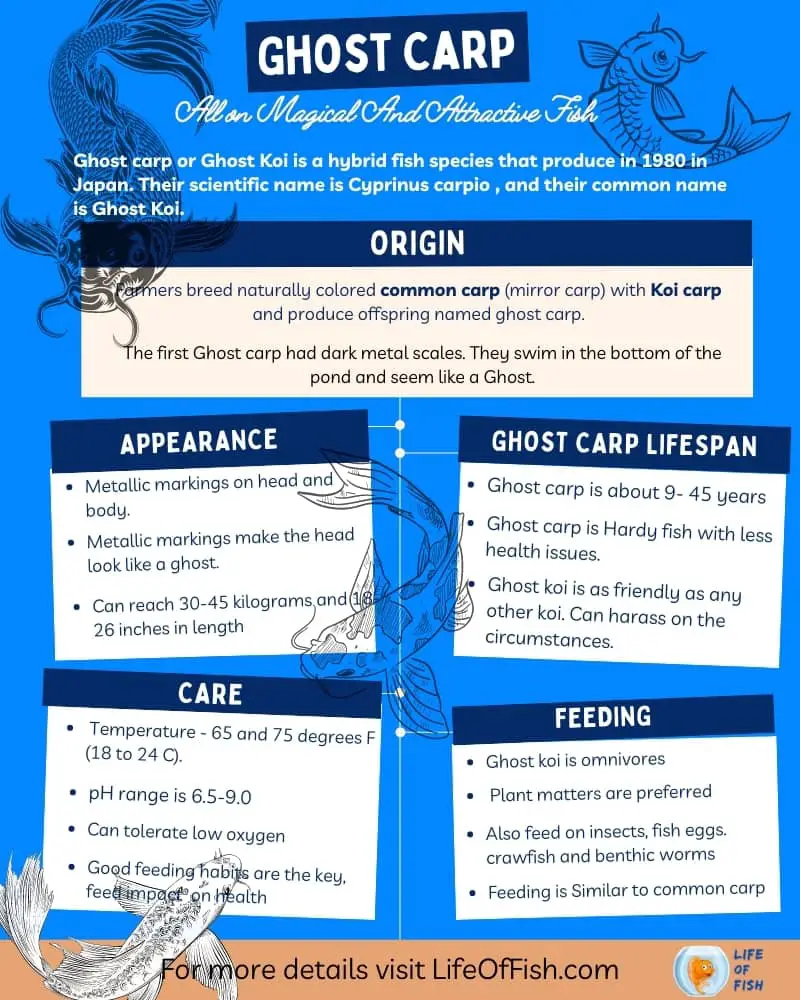Ghost carp or Ghost koi is a magical and attractive variety of carp fish. They have these metallic markings on their body, which make them special. This wonderful fish is a very valuable addition to your pond.
Mark my word, compared to other carps in your pond, ghost carps will stand alone with their ghostly appearance. So, in this article, I am going to share my knowledge of ghost carp with you.

What is a ghost carp?
Jump To
- 1 What is a ghost carp?
- 2 Ghost Koi Fish Origin
- 3 What does a ghost carp look like?
- 4 How big do ghost carp grow
- 5 Ghost carp lifespan
- 6 Do ghost carp eat other fish?
- 7 Is Koi Fish Aggressive?
- 8 Can Ghost carp breed?
- 9 How to care a Ghost Koi? step by step
- 10 What do ghost carp eat?
- 11 How can I make ghost koi grow faster?
- 12 Related questions
- 13 Summary
Ghost carp or Ghost Koi is a hybrid fish species that was found in 1980 in Japan. They are scientifically known as Cyprinus carpio , and their common name is Ghost Koi. Ghost carp is a result of, crossbreeding naturally colored common carp (mirror carp) with Koi carp.
The Ghost carp have dark metal scales, and they can quickly disappear underwater. Because of this ghostly behavior, they earned this name. Interestingly, Ghost carps have many similar traits to True Koi Carp and are genetically identical to Koi Carp (Nishikigoi).
Although they have similarities, they can easily distinguish themselves from other varieties by observing their color pattern, scale arrangements, and coloration. On the other hand, this species has both scales-less and scaled varieties.
Also, these carps have a great number of color varieties, and major colors are red, orange, white, yellow, blue, and cream. You can buy them at any best online freshwater fish stores

Ghost Koi Fish Origin
Ghost carps were introduced to the world in 1980, as a result of a cross-breeding experiment.
In early times, Ghost koi was often completely black in color. But with after so many breeding trials, the current versions are more colorful and come in both scaled and scaleless (Doitsu) variants. Thus, it has become the main feature of many ponds around the world.
Originally, Carp fish are from Asia and Central Europe. In east Asia, they are mainly cultured for food. As you know, Carps are cold-water fish, and they can survive and adapt to many environments and waters.
Ghost carp are a type of Asian carp that originated in China, and they were introduced to the United States in the 1970s as a way to control invasive plants. They’ve since become established across the country. The problem is that these fish eat plants, which means they’re good for cleaning up lakes and rivers, but they also eat other types of fish.
What does a ghost carp look like?
Ghost carp or Ghost koi is a cross-variety of a mirror or common carp and koi carp. You can clearly see the metallic markings on ghost carps heads and around their body.
Apart from that, you can easily see the Ghost carp are set in metallic colors against the carp’s original dark colors, which often come in shades of white, gold, and silver. And also, the markings on the head are what make the carp’s head looks like a ghost.
In contrast to ghost carp, koi carp have more elegant colors such as reds, orange, white and black. Also, you are not able to see metallic patterns on the head and body of koi carps.

How big do ghost carp grow
They can reach around 30-45 kilograms and can grow about 18-26 inches in length in the natural environment. Also, ghost carp are hardy fish than koi carp and they can grow fast.
If we compare them with koi carp, ghost carp grow to an overall size similar to koi carp. But their heavy eating habits often cause them to grow large quickly. The rapid growth is not uncommon for Ghost koi. Ghost carps are famous for their hungry behavior. They always come in first for food and consume the most. They inherit this behavior from their ancestors.
Also, they spent most of their time on the water surface seeking food. This behavior of ghost fish makes them easy to observe.

Ghost carp lifespan
The average lifespan of Ghost carp is about 9- 45 years. You can improve Ghost koi’s lifespan by maintaining good water quality, Good water filtration, stable temperature, and environment, providing high-quality nutrition and predator protection.
Do ghost carp eat other fish?
Although ghost carp are omnivorous, they do not eat small fish. As you know, they eat both vegetables and animal matter, but they mostly prefer a vegetarian diet. And also, they do not show predatory behaviors. Therefore they eat other fish very rarely.
That means, sometimes ghost carp can mistake very small fish for plant matter and swallow it. Maybe sometimes accidentally they can swallow a small fish. Otherwise, ghost carps do not hunt and kill other fish in the pond.
By the name of ghost koi, some people may think they are ferocious. But they are not like that. They are gentle fish.
Is Koi Fish Aggressive?
Ghost koi are as friendly as any other koi.
Although koi are typically gentle and easy-going fish, they can sometimes be aggressive and can harass other fish, depending on the circumstances. Some factors that can be affected koi carp aggression are general temperament, breeding & spawning, lack of space & overstocking, poor quality food & nutrition, illness or injury, heightened stress, poor water quality, and unsuitable pond companions.
If your Ghost carp fish are aggressive, you can stop them by doing the following things.
- You can separate aggressors and quarantine newcomers. For Ghost koi that are naturally aggressive, please keep them in a separate pond from other fish.
- You should maintain good water quality and include plants & shelters. Adding a variety of native and non-toxic plants to your pond will not only improve water quality but also provide valuable housing for your koi. Always make sure your fish are in good health.
- This type of koi is also very active – you can always find them swimming on the surface of your pond looking for food.
If you decide to add a Ghost koi to your pond, make sure you have enough space to accommodate it because this type of koi will quickly grow into one of the largest koi fish in your pond.
Can Ghost carp breed?
Yes. They can be bread in the pond. Ghost koi are fertile hybrids. They can reproduce thousands of offspring naturally as well as artificially. Ghost koi mostly prefer a temperate climate to spawn. Therefore, the weather must be warm enough to achieve success.
The breeding process is simple. When the right time comes, fish search out heavily planted areas in ponds or spawning brushes for mating.
The female fish scatters the eggs, and the male fish fertilizes them just after that. You must keep in mind that, ghost koi likely consume their eggs after laying. Therefore, after laying eggs, it is good to remove the eggs or breeding pair to a separate tank/pond.
How to care a Ghost Koi? step by step
Ghost carps bring a colorful and attractive look to your pond. But you should look after them carefully. Let’s see what are the tips, that help to look after Ghost koi.
1. You must feed them well.
Like any pet, what you feed your Ghost carp has a huge impact on their health and longevity. It is not hard to feed them. As ghost koi are omnivores, so they will eat almost anything you provide.
Most importantly, do not forget to provide quality food. Quality fish foods always promote growth, health as well as color. These quality foods have balanced nutrition that comprised vitamins, proteins, and carbohydrates at the requirement level.
2. Observe your Ghost koi
Observing the appearance and behaviors of your Ghost carp is the best method to ensure the health of fish. Thus, observing your Ghost carp’s behaviors and outer appearances are important to ensure their health.
If you see one of the below signs,
• Not eating
• Change in color
• Visibly injured
• Consistently swimming alone
• Swollen areas
• Raised scales
• Lethargic behavior
Examine your fish and check for the following
• Check underside for damage and injury
• Check gills for damage and discoloration
• Irregular gill motion to sign of oxygen deprivation
• Scales for red markings
3. Check the water in your pond regularly
Regular quality check of your pond water significantly reduces the risk of unhealthy Ghost carp. Periodically check the temperature, and pH level to ensure the water quality in the desired level of fish.
4. Choose the right filter
Many good pond filters help you to keep healthy Ghost carp. The trick is getting the right filter for your pond. Thus, you must choose it correctly, keeping in mind the volume and stock level of your pond and considering future fish growth.
5. Keep the correct water temperature
When they live indoors, koi prefer cool water—between 65 and 75 degrees F (18 to 24 C).
6. Ensure optimum water conditions
Ghost carp are hardy fish that can handle wide ranges of water quality. This is mostly due to they are closely related to wild carp that live in the wild. Ghost carp can tolerate salinity levels up to about 5 PSU is tolerated. The optimal pH range is 6.5-9.0. Also, they can tolerate low oxygen concentration (0.3-0.5 mg/liter) as well as supersaturation.
What do ghost carp eat?
Ghost koi are omnivores. Therefore they will eat anything, but they prefer to eat plants like grass carps. On the other hand, they also like to eat insects and fish eggs. Although it is rare, they can feed on crawfish and benthic worms.
If you have Ghost koi in your pond, you know that they eat anything just like other kids. But you must provide them with nutritious food to promote fish health, size, and color.
Many people doubt that “does Ghost koi eat other fish?” Ghost koi is not that cruel. So the answer is “No”. They rarely eat other fish.
How Often Should You Feed ghost Koi Fish At Different Temperatures?
It’s important to remember that Ghost koi should only be fed when the temperature of their water is over 10 degrees. Ghost koi will eat less when the temperature goes down. Also, ghost koi gradually demand more food as the pond water heats up, as seen in the feeding frequency chart below.
| Water Temp. (°C.) | Water Temp. (°F) | Feeding Frequency |
|---|---|---|
| Less than 10ºc | Less than | Do not feed |
| 10-13ºc | 50-55 | 2-3 times a week |
| 13-15ºc | 55-59 | 4-5 times per week |
| 16ºc | 61 | Once per day 5-6 days per week |
| 16-18ºc | 61-65 | Once per day every day |
| 18-22ºc | 65-71.5 | Once or twice every day |
| 22-25 ºc | 71.5-77 | Up to 3-5 times per day |
What to feed Ghost carp other than fish foods
You may give your Ghost koi a variety of things in addition to fish food. Aside from fish food, what are some of the finest things to feed your koi? But keep in mind this food must be given on rare occasions and in small quantities.
- Prawns
- Shrimp
- Shelled crab
- Daphnia
- Feeder fish
- Cockles
- Worms of all sorts
- Sweet corn
- Oranges
- Lettuce
- Spinach
- Cucumber
- Zucchini
- Other leafy greens
- Bread
How Long Can They Go Without Food
Ghost koi carp are capable of surviving for several days without being fed. Despite the fact that they may be hungry after 3 or 4 days without food from you, they will not starve. However, by day 5, make sure to feed them something substantial. They will, without a doubt, be hungry by this point, but they will not perish as a result.
They may even be able to survive for a longer period of time if the pond in which they inhabit has a high level of ecological diversity. Providing there is plenty of algae, some tiny fish, and other plant materials in the pond, as well as insects, they will be able to scavenge for food. While Ghost koi are not likely to be able to survive for more than 4 or 5 days without food of any kind, they are capable of searching for it on their own in the pond.
In other words, it’s not a great concern if you miss a feeding every now and then; nevertheless, try not to do so on a regular basis.
How can I make ghost koi grow faster?
Maintaining the proper water temperature in the tank or pond and optimum feeding is the best strategy to ensure that your Ghost koi fish grows as quickly as possible. If you want your koi to grow quickly, keep the water temperature in the pond between 77 and 80 degrees Fahrenheit. Because this can increase ghost carp fish feeding rate as I told earlier.
Furthermore, ensuring that your Ghost koi fish are fed a balanced diet and have plenty of food will ensure fast growth.
Read more: Koi Angelfish | Care Guide & 15 Things Must Know
Read more: Siamese Doll Goldfish Care 12 Things Must Know
Related questions
What kind of habitat does ghost carp prefer?
They have been known to live in both fresh water. The habitat of this species is very unique and can be difficult to understand.
Ghost carp prefer to live in muddy bottoms that are covered with aquatic plants. They are able to survive in many different types of water, so their preferred habitat does not always have to be muddy bottoms with plants. They will also thrive in areas where there is a lot of vegetation and roots that can provide shelter for them from predators.
Is a koi a ghost carp?
No, Ghost carp is another variation of koi. And it is a hybrid one. This fish is a result of breeding Mirror or Common Carp with koi carp. Variations in these can cause large color changes in Ghost carp from bright white to gunmetal grey, which may develop with age.
As normal with hybrids, they are more powerful in terms of growth and health than koi carp and can compete well for food with all varieties of Cyprinus carpio that live in the wild and breed with each other.
Are ghost carp rare?
Simply Ghost koi is not rare. Though Ghost carp is a hybrid, they are fertile. They can breed with each other naturally as well as artificially. Therefore, it helps to grow their population. They can produce more than 10,000 offspring per breed. They can survive in wide environment ranges. Their ideal range of pH levels is 7.5 to 8. Ghost koi can live anywhere in the water between 34- and 90-degrees Fahrenheit.
But their survival rate depends on environmental factors such as food availability, space, predatory activities, etc. And they are omnivorous. Therefore, they can feed easily. Thus, the Ghost koi is not rare and is commonly found all over the world
Are ghost koi Hardy?
Considering their relationship with the original wild carp, Ghost carp is very hardy. But, as expected, all fish-based parasites can affect this fish. But there are less health issues with Ghost koi. They work well with parasitic infestations.
Do ghost koi kill other fish?
Although Ghost carp is omnivorous, they mostly prefer vegetable matters. They are typically gentle and friendly. And also, they are not predatory. Therefore, they eat other fish very rarely. When hearing the name Ghost koi, someone may think, that Ghost koi is violent. But they got this name because the first Ghost carp had dark metal scales and quickly disappeared underwater.
Are ghost carp invisible in water?
Ghost carp are not invisible in water, but their bodies do have a sort of natural camouflage. The fish have soft skin that is translucent, and their scales reflect light in such a way that it makes them difficult to see. This means that the fish can be hard for humans to spot, but it doesn’t mean that they disappear completely.
Are ghost carp illegal?
The ghost carp is not illegal in any country, but it may be against the law to import these fish into your country if you don’t have permission from the government. The best thing you can do is check with your local authorities before importing any fish species into your area; this will help ensure that your new pet doesn’t come with any unwanted legal consequences!
Summary
Ghost carp are sometimes confused with invasive and destructive breeds of carp such as the Asian carp because they can hide in schools and consume most anything that enters the water. Unfortunately, this doesn’t mean the fish is any less dangerous. A pond or aquarium would benefit greatly from housing ghost carp. They are simple to take care of and eat a range of foods. Simply maintain the temperature, keep an eye on the pH and water quality, and don’t overcrowd or overfeed your tank with fish. I appreciate your reading!

